Sustainable Development Topics
Technology
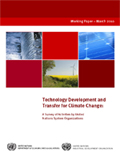 |
TITLE | Technology Development and Transfer for Climate Change: A Survey of Activities by United Nations System Organizations [pdf 2,273 KB] |
| DATE | March 2010 | |
| Working Paper – March 2010 prepared jointly by DESA and UNIDO. This survey provides an updated non-comprehensive overview of the range of related United Nations activities and considers some opportunities for enhancing the United Nation’s role in this critical area. The survey highlights the major efforts of United Nations system organizations, the types of activity and the extent of their coverage. The work of many of these organizations includes a focus on the complex issue of technology development and transfer. This survey identified a wealth of ongoing initiatives, highlights of which are contained in Table 1, structured according to key themes, and elaborated in part II after the introduction of this report. These initiatives are complemented by numerous activities, which build on partnerships between United Nations organizations and collaborations with other international organizations, governments and nongovernmental entities. These joint efforts are highlighted in part III of this survey. When compiling the initiatives presented in this survey, a number of areas emerged, which could offer effective opportunities for enhancing the United Nations system’s engagement. These areas, which are further described in part IV of this survey, are briefly summarised as... see the paper for details |
||
 |
TITLE | World Economic and Social Survey 2009: Promoting Development, Saving the Planet |
| DATE | September 2009 | |
| The World Economic and Social Survey (WESS) provides objective analysis of pressing long-term social and economic development issues, and discusses the positive and negative impact of corresponding policies. The analyses are supported by analytical research and data included in the annex. | ||
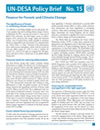 |
Policy Brief #20 | UNDESA Policy Brief # 20: Multidimensional Climate Threats Require New Approaches & More Resources for Adaptation Challenge August 2009 [pdf 96 KB] |
| Policy Brief #19 | UNDESA Policy Brief # 19: Technology Transfer & Climate Change: Beyond TRIPS August 2009 [pdf 120 KB] |
|
| Policy Brief #18 | UNDESA Policy Brief # 18: Climate Change and Technology Transfer: The Need for a Regional Perspective July 2009 [pdf 100 KB] |
|
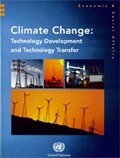 |
TITLE | Climate Change:
Technology Development & Technology Transfer [pdf 1.3 MB] |
| DATE | 2008 | |
| CONTENTS excerpt: |
I. Introduction..............................................................................1 II. Technologies, technology transfer and barriers.............................11 III. Mechanisms for enhancing technology development and transfer..38 IV. Public-private roles and partnerships for innovation and technology transfer.......................................................................................67 |
|
 |
TITLE | Climate Policies & Sustainable Development [pdf 990 KB] |
| DATE | 2007 | |
 |
TITLE | CLEAN AND COMPETITIVE: Environmental Management Accounting for Business [pdf 562 KB] |
| DATE | March 2003 | |
| SNAPSHOT |
Management Activities that Benefit from EMA
|
|
 |
TITLE | MEASUREMENT FOR IMPROVED ENVIRONMENTAL & ECONOMIC PERFORMANCE: Environmental Management Accounting for Government [pdf 530 KB] |
| DATE | March 2003 | |
| SNAPSHOT | Benefits to Government of EMA Implementation by business
EMA increases the range of instruments and organizations involved in the environmental and economic policy mix, and helps government to achieve its policy goals in that:
|
|
 |
TITLE | Environmental Management Accounting: Policies and Linkages [pdf 1,269 KB] Czech | English |
| DATE | 2001 | |
CONTENTS partial list: |
|
|
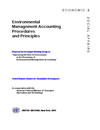 |
TITLE | Environmental Management Accounting: Procedures
and Principles [pdf 1,500 KB] Czech | English | German | Japanese | Portuguese |
| DATE | 2001 | |
CONTENTS partial list: |
|
|
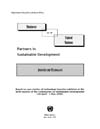 |
TITLE | Business and the UN: Partners in Sustainable Development 1999 [pdf 1,500 KB] |
| DATE | 1999 | |
PREFACE excerpt: |
A central factor in achieving sustainability in business and industry is the improvement of production
processes through the introduction of technologies that use resources more efficiently and minimize
environmental impacts. If such cleaner production technologies are to be widely adopted without costly
regulations, they must be cost-effective and fit into normal business decision making. The purpose of the
Industry and Technology Exhibits and Presentations organized during the sixth session of the Commission on
Sustainable Development (CSD) was to examine, through case studies, the process of transfer of cleaner
production technologies from enterprises in developed countries to enterprises in developing countries...
This publication explores the motivations of companies involved in nine cases of successful transfer of cleaner production technologies to enterprises in developing countries. These companies presented their stories during the Industry and Technologies Exhibits and Presentations. Part I offers a summary of the case studies... |
|

